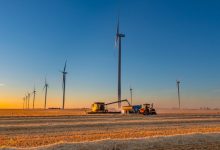The Coalition’s dogmatic pursuit of nuclear energy has been eviscerated by energy analysts who say that it will likely be used to slow down the rollout of renewables and make it extraordinarily difficult to reach net zero.
The assessment by the team behind the landmark “Net Zero Australia” report essentially bells the cat on the reasons behind the nuclear push by the federal Coalition, conservative media, and some key fossil fuel industry players.
It has long been recognised that nuclear is “too slow and too expensive”, as former chief scientist Alan Finkel – otherwise an admirer of the technology – explained in great detail in a recent episode of the Energy Insiders podcast.
Now, Robin Batterham, another former chief scientist, and another former proponent on nuclear power, has repeated that assessment but gone further – arguing that pursuing nuclear is a distraction that puts Australia’s net zero targets in danger.
“To reduce renewable targets in the belief that nuclear will be deployed later at scale would create a material risk of not achieving net zero, or doing so at an excessive cost,” the report says.
Yet, that is exactly what the Coalition is proposing in its ideological opposition to green energy and strong climate action.
The call for nuclear has long been associated with climate deniers, but is now being used as a tool to question and slow down the rollout of renewables in Australia, and delay the closure of fossil fuels, with the Coalition, the Murdoch media and even the AFR as chief protagonists.
The latest publication by Net Zero Australia focuses on what is needed to be done to ensure that the country can reach its net zero targets, and tap into the massive opportunities it has as a renewable energy “superpower”, with massive industries based around zero carbon power and technologies.
Essentially, the report says, Australia needs to do everything it can to go faster, particularly as the slew of temperature records and ice measurements suggest the world is hurtling towards a tipping point on climate.
“It’s not useful to debate whether we will or won’t make it,” Batterham says. “Our priority should be to plan well, get on with it, and adapt to the lessons we learn.”
The Net Zero Australia report, as we reported in its first release in April, canvasses six potential scenarios towards new zero, with the biggest swing factors being the pace of electrification, the rollout of renewables, and the ability of Australia to build “added value” industries that can profit from its rich wind and solar resources.
Some of the numbers emerging from its modelling are eye-watering – multiple terawatts of wind and solar needed to support a “renewable superpower economy” at a potential cost of up to $9 trillion by 2060.
Those numbers have been criticised by many in the industry as fantastical and a little too scary, and the report has been accused of reaching conclusions that satisfy its sponsors, notably gas companies such as APA and Woodside, hydrogen promoters such as Andrew Forrest, and carbon capture and storage proponents.
But Batterham rejects those claims. He says that the electrification scenarios do take into account the likely reduction in primary energy – mainly because producing power from wind and solar for transport and buildings is so much more efficient than burning fossil fuels – be their oil, gas and coal.
Batterham says that Australia, if you include things like road transport ($50 billion a year of imported fuels) and buildings, and other unavoidable investments, will spend nearly that much on a business as usual case over the next 40 years.
And, in the renewable export scenarios, Batterham says that much of the capital cost will come from those wanting to buy the product, as occurred in the past LNG and mining booms. And the advantage of zero emissions technology is that it will deliver clear benefits – to health, the climate and the economy.
“We will spend $1.5 trillion just replacing our current kit, things that are worn out,” Batterham says. “To turn Australia into an exporter on low emission energy, be it a hydrogen carrier of some sort or a cable, that will come from people who want that energy.”
The more immediate concerns for the authors of the Net Zero Australia report, which includes the Nous Group, the University of Melbourne, the University of Queensland and Princetown University in the US is what happens in the crucial next few years out to 2030.
Batterham says there is no time to lose, and the report says investment is urgently needed in more solar, onshore wind, batteries, pumped hydro, and transmission, and offshore wind should start producing from 2030.
It also states that energy productivity should be boosted and fossil fuel centres transformed into solar-hydrogen industrial hubs.
“We’re not investing fast enough; hard as it is, we need to accelerate,” the report says.
Other more contentious proposals include the need to build significant amounts of new peaking gas facilities, and to decide the fate of existing gas networks, and whether they should be preserved for products like bio-methane.
Batterham also insists that there will be no choice but to embrace carbon capture and storage – not to extend the life of fossil fuel generator, but to eliminate the emissions of hard to abate sectors. It will be CCS or offsets, and CCS is likely to be more efficient.











